Please note: This article contains affiliate links to tools we use and love, and we may receive a commission if you click through and make a purchase.
So, you’ve been diligently working on search engine optimization (SEO) for your brand.
You’ve spent hours fine-tuning those keywords, creating content you’re proud of, and optimizing every nook and cranny of your website.
But amid all this hustle, a thought nags at the back of your mind: Is all this work translating into actual value?
That’s what we’re getting into today — how to measure SEO ROI (return on investment). We’ll show you how to determine if your SEO efforts are generating tangible monetary value for your brand.
Ready to measure, analyze, and perhaps even do a little celebratory dance? Let’s get right into it.
SEO ROI: The Basics
SEO return on investment is simply a measure of the value or profit your business receives from its SEO efforts compared to the costs invested in these efforts.
A positive ROI means the strategies you’re using are yielding more in returns than they cost, signaling a profitable investment.
On the flip side, a negative ROI means the costs outweigh the financial benefits, suggesting a potential need to reassess or modify your current approach.
An important note before we continue: Measuring SEO ROI isn’t an exact science. We’ll delve into the complexities later, but for now, just bear in mind that if you do the math and the numbers seem a little gloomy, there might be more to the story.
Why You Should Measure SEO ROI
Imagine the internet as a big, bustling shopping mall. It’s crowded and noisy, and every storefront is vying for attention.
Now, picture SEO as your glitzy neon sign basically shouting, “Hey, over here!” — luring shoppers to your store or, in this case, your business website.
In today’s fiercely competitive digital marketplace, an SEO strategy is not just a “nice to have” — it’s a necessity. Don’t believe us? Just check out these stats:
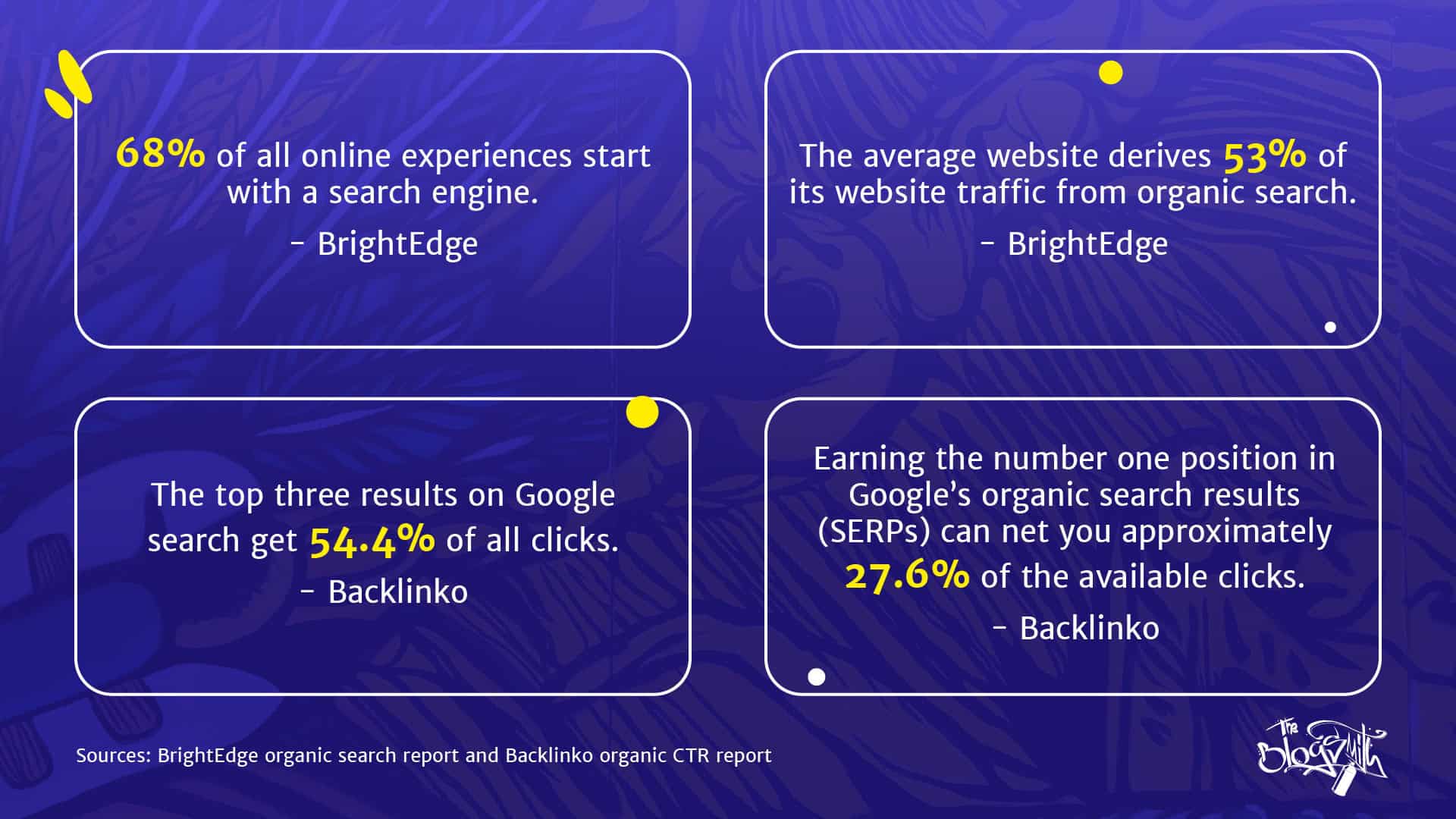
To put it simply, SEO helps more folks find and visit your website, and it involves optimizing your content not just for humans but also for robots. To find out more about how to do that, check out The Blogsmith Founder Maddy Osman’s book, Writing for Humans and Robots: The New Rules of Content Style.
But here’s the other thing: SEO includes a significant investment of time, resources, and — yes — good ol’ dollars. As with any other endeavor, you want to know that the reward is worth the investment. After all, you don’t want to be putting time and resources into something that’s not working.
Measuring your SEO ROI has many other benefits. For example, SEO ROI also helps you:
Demonstrate the Value of SEO to the Higher-ups
In a business environment where marketing budgets are under constant scrutiny, definitive SEO ROI data helps validate the significance of SEO as a marketing channel. This ensures continued investment, funding, and support from the key decision-makers or stakeholders of your organization.
After all, when you’re trying to convince the higher-ups to boost your budget, nothing speaks louder than cold, hard numbers.

Evaluate the Efficiency of Specific SEO Elements
SEO consists of numerous parts. Some of these might shine brighter than others, driving substantial value for your business, while others might not shine at all.
For example, maybe a certain keyword is bringing a rush of traffic and conversions, but another seemingly popular keyword is a dud. Perhaps one of your blog posts is gaining massive traction while others are gathering digital cobwebs. Or maybe some of your link-building tactics are propelling your website up the SERPs, while others aren’t moving the needle at all.
The only true way to determine which is which is by measuring the ROI of each.
"By tracking the ROI of specific on- and off-page elements, you see which parts of your SEO content strategy are hitting the mark perfectly, need some tweaking, and are a total miss."
Evaluating SEO ROI this way offers a better understanding of each component’s performance, allowing for more targeted improvements.
Allocate Resources More Wisely
With ROI insights, you can channel your time and budget toward activities or components that are bringing in the highest return.
For example, if you find that long-form content delivers more organic traffic and conversions compared to shorter pieces, you might decide to channel more of your time and resources in that direction. Or you might focus more of your efforts on acquiring backlinks exclusively from high-authority domains.
Set Realistic Expectations, Forecasts, or Benchmarks
By understanding the value of your SEO efforts relative to their cost, you can set clearer and more realistic expectations or benchmarks for future campaigns. This process also helps you see if you’ve been setting your sights too low or perhaps not fully taking advantage of the best opportunities.
How To Measure SEO ROI
To measure the SEO ROI for your brand, subtract the cost of your investment from your organic traffic revenue. Then, divide that number by the cost and multiply the result by 100.
Here’s the formula:
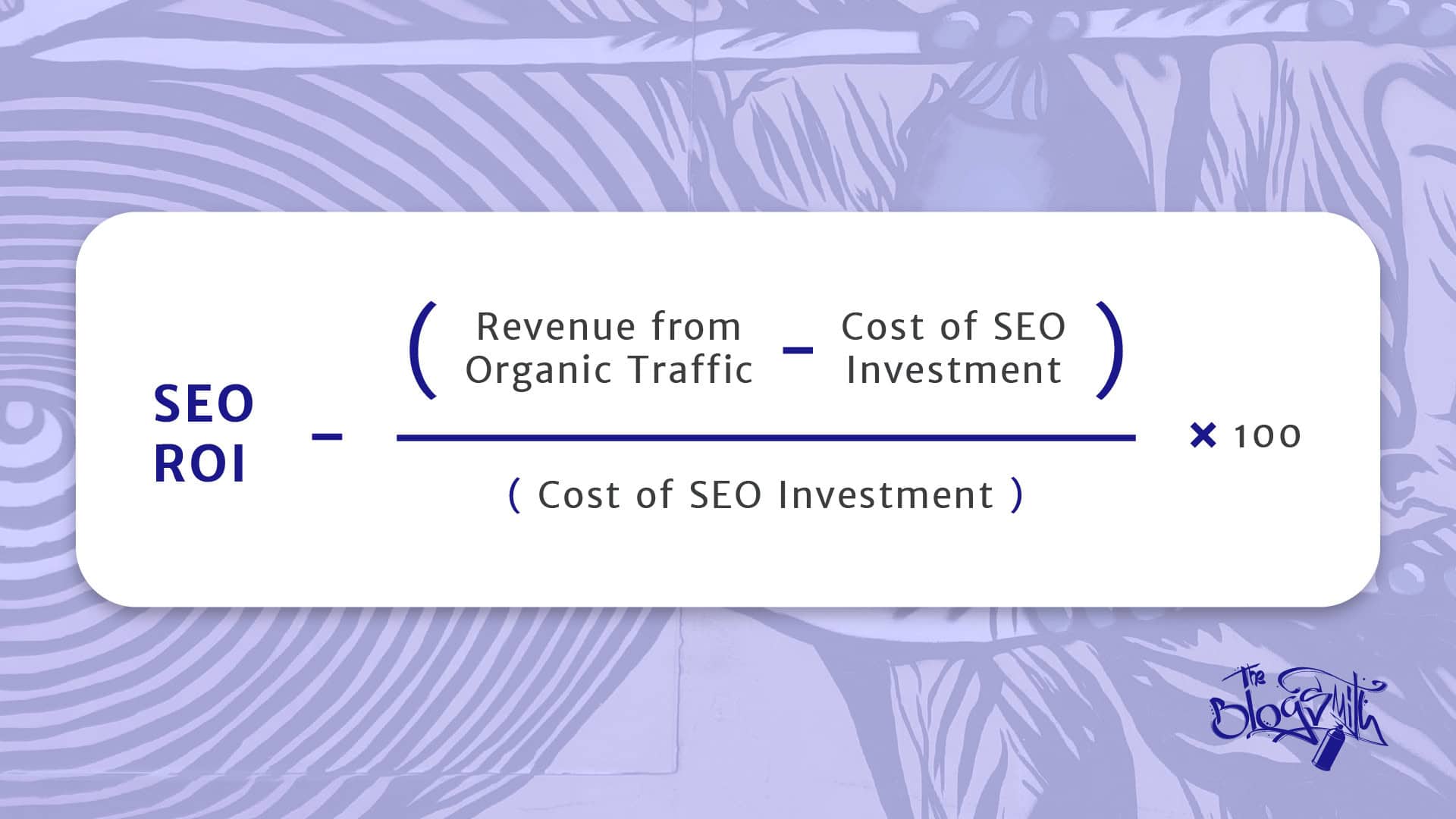
Steps for Measuring SEO ROI
The best way to measure SEO ROI is to approach things step by step. Here’s a simple guide you can use.
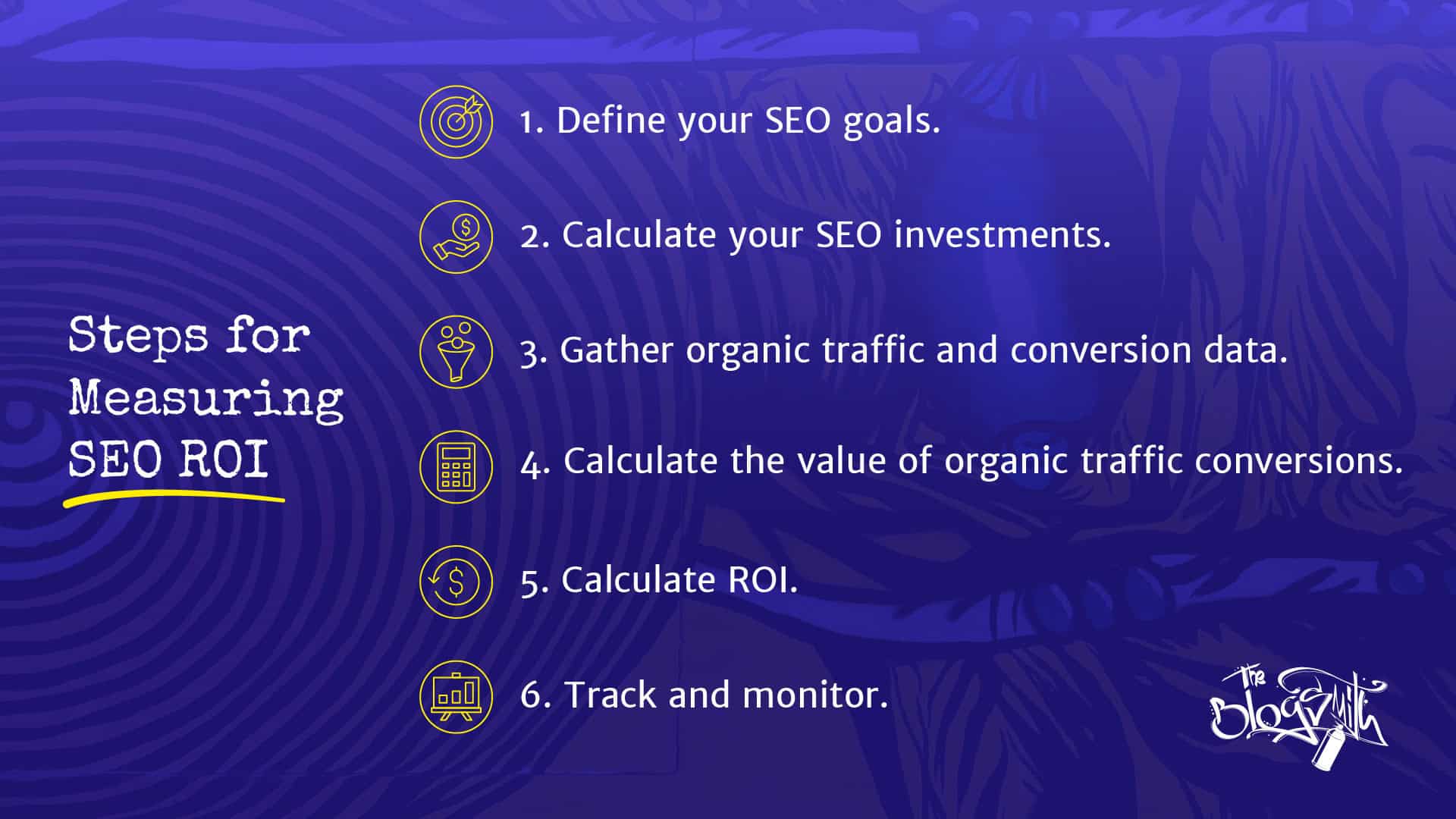
1. Define Your SEO Goals
At the beginning of your SEO campaign, sit down and clearly define what success looks like for you.
Typical overarching SEO goals include:
- Increasing web traffic
- Increasing lead generation
- Boosting sales
- Increasing brand awareness
- Boosting domain authority
- Reducing marketing costs (cost-effective way to drive targeted traffic and conversions)
- Minimizing technical issues
- Improving website structure and page experience
- Improving conversion rates by driving targeted traffic
- Improving company reputation (positive reviews)
- Boosting credibility and trust
Determining your goals lays a solid foundation for the ROI evaluation that follows.
To make sure your goals are effective and actionable, follow what is called the SMART model. SMART stands for specific, measurable, achievable, relevant, and time-bound.
2. Add Up Your SEO Investments
This is where the real math starts, so get your calculator out. For most brands, common SEO expenses include:
- Salaries or wages of in-house SEO staff, like content managers, editors, and writers
- SEO tools and software, such as:
- Keyword research tools (e.g., Semrush and Ahrefs)
- Content optimization tools (e.g., Clearscope, Frase, and MarketMuse)
- Rank-tracking tools (e.g., SE Ranking and SerpWatch)
- Technical SEO tools (e.g., Screaming Frog)
- Analytics and tracking tools (e.g., Google Analytics and Adobe Analytics)
- Fees for SEO freelancers, consultants, or content marketing agencies
- Any training programs, webinars, or courses to enhance your in-house team’s or freelancers’ SEO expertise
- Any costs incurred in acquiring valuable backlinks
Tally up these costs for your chosen evaluation period. You can go with a short timeframe (like a month) or a long timeframe (like a year).
A short period enables timely optimization by letting you quickly see where you can improve. The tradeoff is the potential for inaccurate results due to the limited time window.
On the other hand, a long time frame provides a comprehensive view of the sustained or long-term value and benefits derived from SEO. The downside is that without more frequent evaluations, you might continue to invest in ineffective strategies.
3. Gather Organic Traffic and Conversion Data
The next step in the process of measuring SEO ROI is to gather some critical data, specifically:
Organic Traffic Data
- Total monthly searches for your keyword(s).
- Click-through rate (CTR), i.e., the percentage of searchers who click on your website from the search results.
- Average search engine results page (SERP) ranking.
Conversion Data
- Conversion rate, i.e., the percentage of people who complete a desired action on your website. The average website conversion rate from organic traffic is 2.7%.
- Average value of each conversion.
You can track and measure this data using a combination of keyword research tools and free tools from Google, such as Google Search Console and Google Analytics.
Important note: In business models where the conversion isn’t a sale — e.g., lead generation — you’ll need to personally attribute a dollar value to each conversion to get the average value per conversion. Typically, this involves leveraging industry statistics or past results.
For example, you can use the percentage of leads who have previously converted into paying customers to determine the value of each lead. If one out of 10 leads on your website has historically gone on to make a purchase worth $100, you can approximate each lead’s value to be $10.
Additional SEO Key Performance Indicators (KPIs) To Monitor
While the KPIs we’ve mentioned above are the most critical for measuring SEO ROI, here are a few more that could also be worth keeping an eye on:
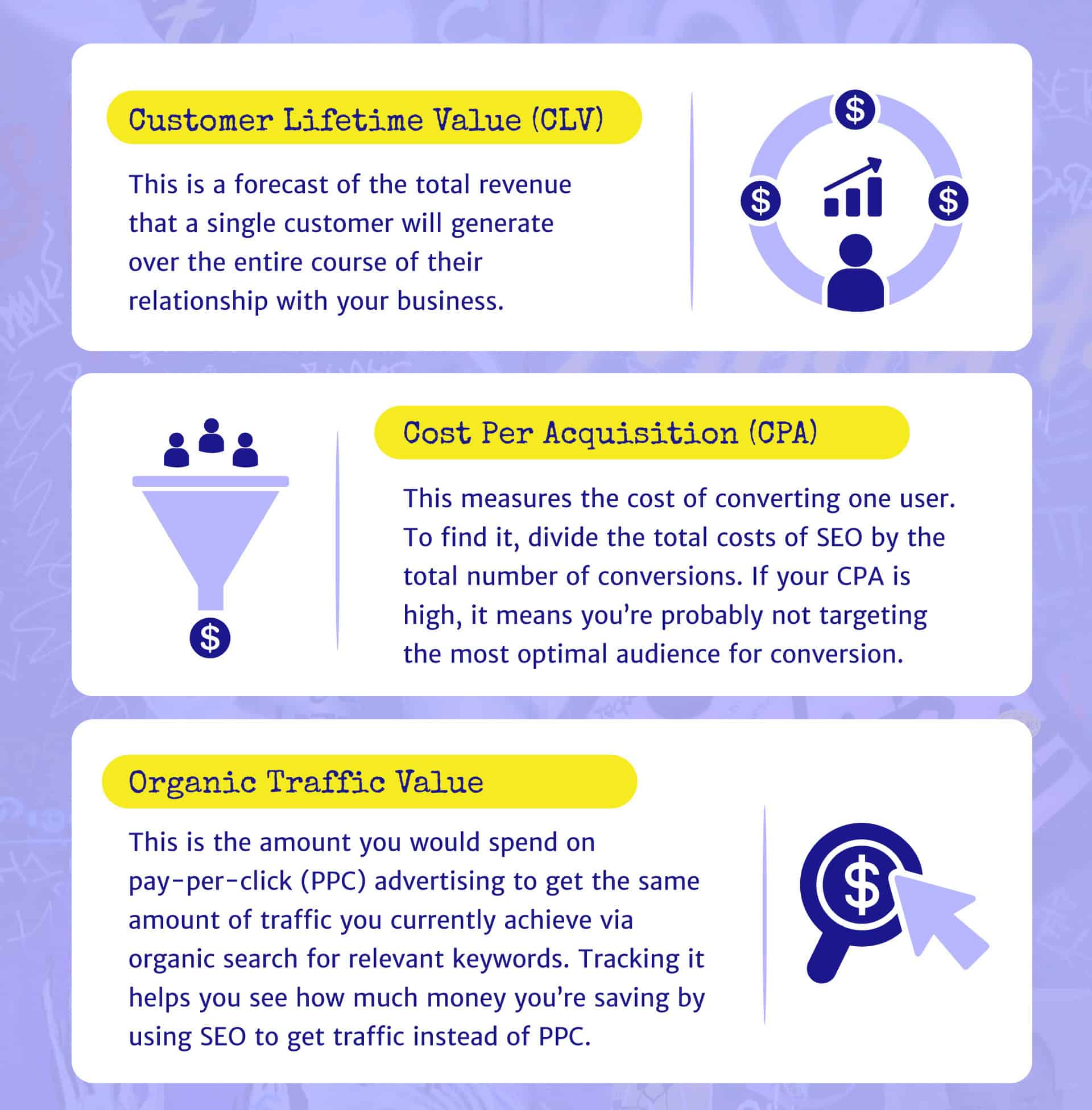
These three KPIs can help paint a more holistic picture of SEO performance and profitability.
4. Calculate the Value of Organic Traffic Conversions
Next, we need to calculate the value of organic traffic conversions. We can do that using the following formula:
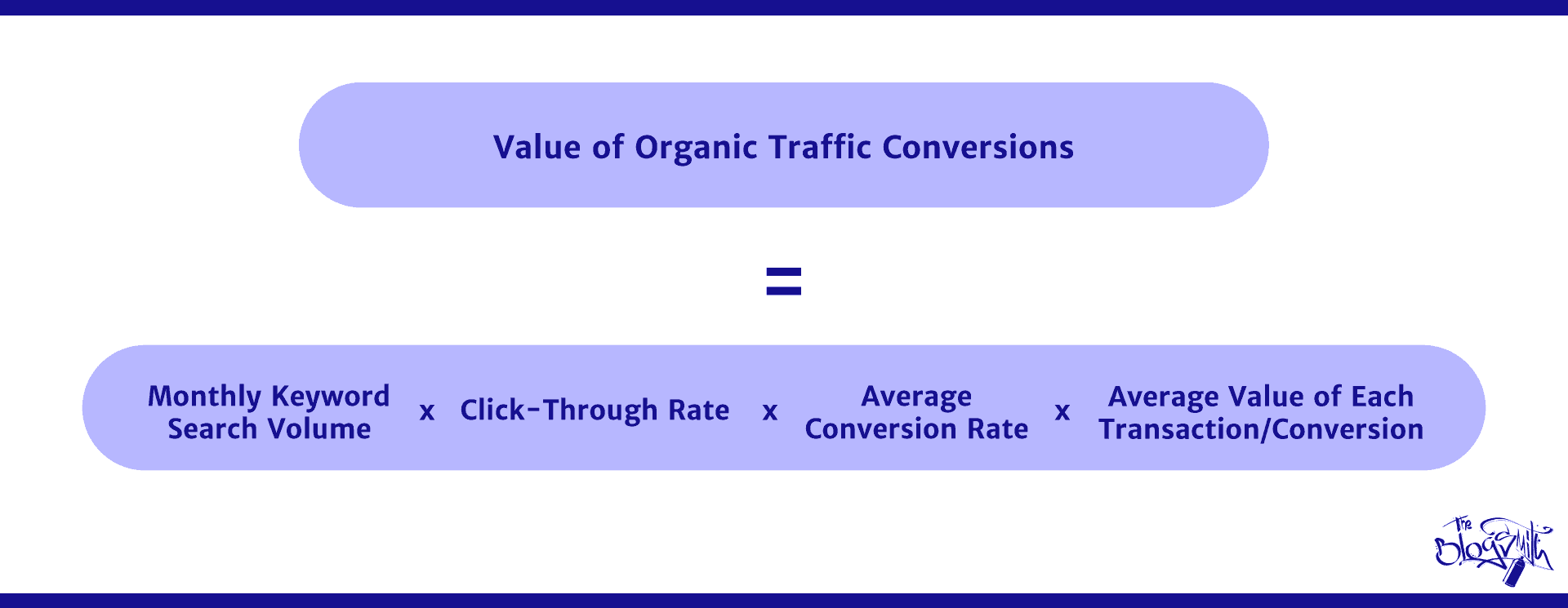
Here’s an example:
Let’s say you’ve started an SEO campaign to enhance subscriptions to your email newsletter.
In this campaign, you’re targeting keywords with a combined monthly search volume of 10,000.
Now, assume you create a content asset, like a blog post, that gets the number one position in Google Search results for those keywords. You manage to capture 2,760 clicks, or a 27.6% CTR — the average for the first result on Google, as we saw before.
Out of these visits, you converted 65, or 2.36%.
Having analyzed past results or industry stats, you estimate that each signup holds an average future transaction value of $50. Using these figures, the return comes down to $3,256.80, calculated as:
Value of Organic Traffic Conversions = 10,000 x 0.276 x 0.0236 x $50 = $3,256.80
5. Calculate Your ROI
Now that we have all the required data in hand, it’s time to use the ROI formula described earlier.
Let’s say that from step 2, your SEO costs for this campaign amount to $400.
So, ROI becomes:
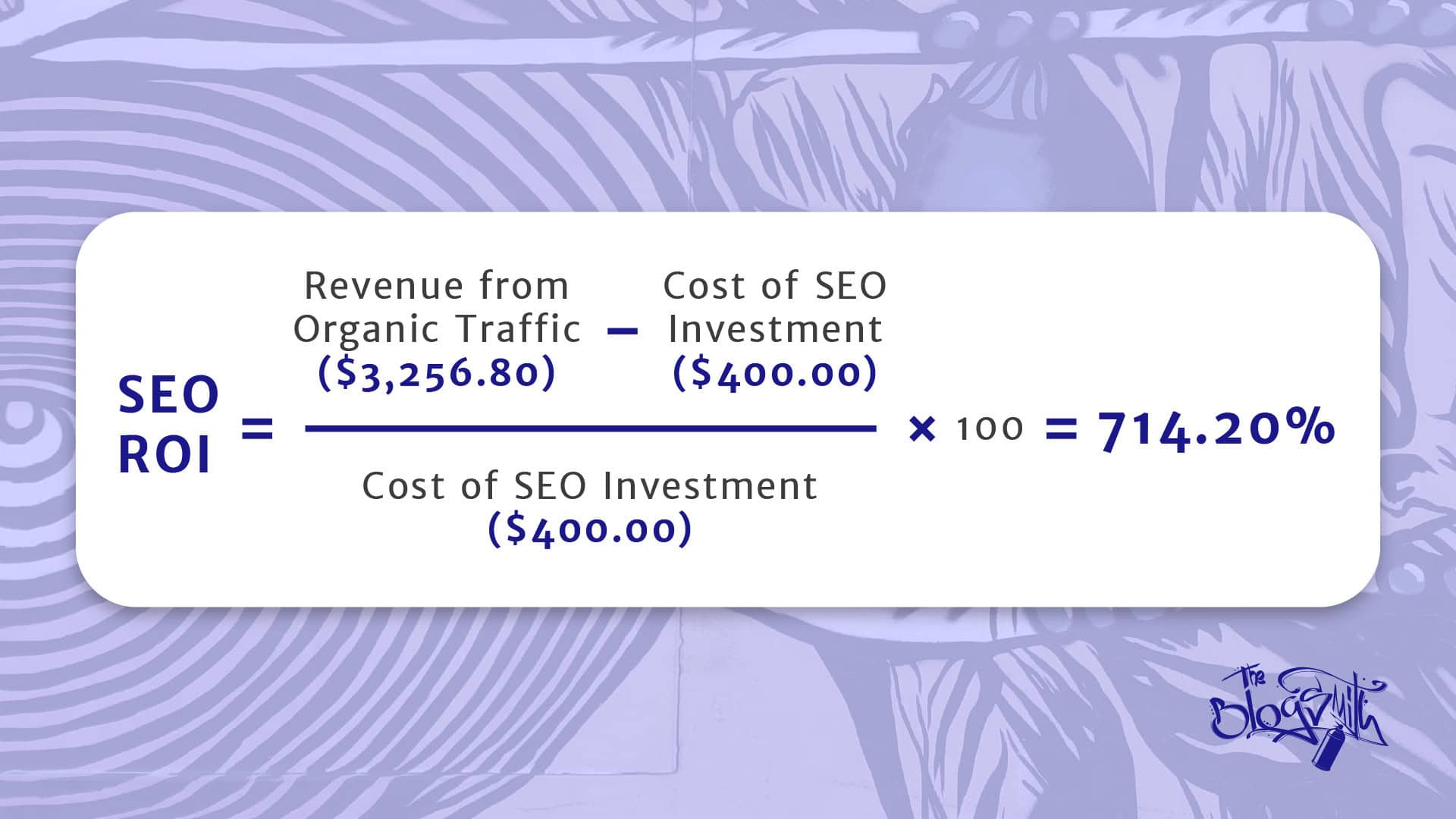
That means for every $1 spent on SEO, it returned over $7. That’s a decent ROI, as we’ll see later, so take some time to celebrate.

6. Track and Monitor Your ROI
As much as we’d all love it to be, SEO isn’t a one-and-done game.
As trends change, search engine algorithms update, and competition rises or wanes, your SEO strategies need to adapt. But how do you know when to pivot?

Simple — by monitoring and tracking your ROI regularly.
This can provide insights into how your current strategies are fairing — including any changes you might have made after your last assessment.
Are you seeing consistent growth? Fantastic! Keep doing what you’re doing. Experiencing a dip? Time to adjust your approach.
In essence, tracking and monitoring ROI can help ensure you’re getting the most bang for your SEO buck.
Challenges of Measuring SEO ROI
Measuring the ROI of your SEO isn’t a walk in the park. Here are a few key challenges to be aware of.
Results Take Time
Unlike other types of digital marketing endeavors, like PPC, which can often yield immediate results, the benefits of SEO usually take time to materialize.
Indeed, depending on a wide range of factors — such as your website’s authority, the competitiveness of your industry, and the specific nature of your SEO strategies — it can take months to see measurable results.
For a brand-new company with absolutely zero online presence, it could even take years to establish domain authority, especially if it’s in a highly competitive field.
The solution? Start your optimization efforts as soon as possible. An early start gives you time to monitor progress, refine strategies based on actual performance, and progressively build toward achieving sustainable SEO success.
Keeping this long-term perspective is essential when measuring SEO ROI.
The primary value of SEO lies in its sustainable impact.
"Whereas with paid search, traffic trickles in only as long as you're pumping money into it, SEO ensures a longer-lasting presence in search rankings, resulting in more prolonged and continuous benefits."
So, how long should you wait before measuring SEO ROI? A good rule of thumb is at least 3-6 months, which is the average time it takes to see SEO results, according to Ahrefs.
Difficulty in Measuring Retention’s Impact
Good SEO does more than just attract new visitors to your website. It also provides helpful and relevant content that increases current customers’ trust in your brand.
The greater the trust customers have in your company, the more likely they are to stick around and keep buying or using your products. So, essentially, SEO can increase your CLV.
But here’s the challenge: It’s difficult to take this benefit into account when measuring SEO ROI. Even if you recognize that SEO is helping retain customers, there’s no straightforward method to measure its impact.
The solution here is to look beyond the numbers. Use qualitative data and tools, such as customer satisfaction surveys and feedback on content usefulness, to gauge how well your SEO efforts are resonating with your audience.
You could also monitor engagement metrics, such as return visitor rate and time on site, to infer the indirect impact of SEO on customer retention.
Lack of Control
A lot of elements are out of your control when it comes to SEO. For example, your website’s ranking is solely determined by search engines like Google.
While there are a few known best practices for improving your ranking, we don’t know the specifics of how Google operates. It’s never 100% clear what will drive your business to the top of SERPs.
And even when you think you’ve cracked the code, search engines are constantly updating their algorithms. These updates can cause abrupt fluctuations in traffic and rankings, complicating ROI calculations.
The key is to stay informed and adaptable. Regularly update your knowledge of SEO best practices and remain flexible in your strategies to accommodate elements like search engine updates.
Diversifying your marketing efforts can also reduce the risk of negative impacts from search engine changes.
When in doubt, don’t hesitate to reach out to experts. For example, here at The Blogsmith, we pride ourselves on staying current with industry trends, including any Google algorithm changes. When you partner with us, you can be sure that your SEO content strategy will always be up to date.
Difficulty in Isolating SEO Efforts
If you’re using a multifaceted content marketing strategy for your brand, other efforts might amplify or overshadow the effects of SEO, making it difficult to accurately measure its ROI.

Consider this scenario:
A potential customer discovers your website via organic search results and visits it, but then they leave without converting. Later, after encountering a post from your brand on social media, they return to your website and complete a transaction.
Which touchpoint truly deserves credit for the conversion?
Although tools like Google Analytics offer a choice of several attribution models to assign credit to different touchpoints in a customer’s journey, it’s difficult to accurately assess SEO’s unique contribution to conversions when it’s part of a larger ecosystem.
The solution to this challenge is to embrace a holistic view of your marketing efforts. Recognize that SEO is a critical part of marketing but works best in concert with other strategies.
What’s a Good SEO ROI?
There’s no magic number.
First, there are many variables at play when it comes to SEO — type of industry, level of competitiveness, specific SEO strategies, amount of investment, and time spent.
And even in a situation where all the above variables are the same, what you consider as an acceptable ROI, another person might see as unacceptable, and vice versa.
That said, a general ROI benchmark that you can apply to SEO is the 5:1 ratio. That means for every dollar you spend, you get back $5, which translates to a 500% ROI.
To reiterate, this is a rough standard, so don’t be disheartened if you don’t meet it right away. As mentioned, SEO is a long-term investment, and its true value unfolds over time.
Also, remember that your SEO ROI is not set in stone. It can always improve, especially with some help from content marketing experts like The Blogsmith.
Final Thoughts: How To Measure SEO ROI — a Comprehensive Guide for Brands
Measuring SEO ROI can help make sense of whether the SEO efforts you’re investing in are providing meaningful value to your company.
This can be pivotal in convincing decision-makers to continue funding or investing in SEO. Measuring ROI can also give you valuable insights that can help you improve your SEO strategy and use your resources more wisely for the best results.
With The Blogsmith, we help you monitor how well your content is performing and craft a strategy for growth. Get in touch today to find out more.












